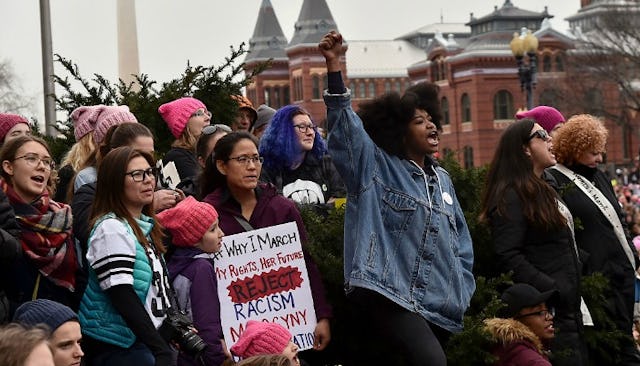The Revolution Will Be Intersectional, So White Feminists Need To Learn What This Means

The Women’s March left me feeling so empowered and inspired. I raised my fist in solidarity and sang the marvelous “The hell you talkin’ ’bout” chant. For one red-hot minute, I was totally convinced that the collective we — the people demanding peace and change and justice — could win this thing, could effect positive change and override some of the harmful policies our new POTUS has promised.
But then I scrolled through Facebook. And while I was moved by the witty, sarcastic, inspiring, and sometimes hilarious protest signs and the enormous, diverse crowds standing in solidarity, it also became painfully clear that many white feminists lacked a basic understanding of intersectionality. It’s this lack of awareness that threatens to derail a true feminist revolution.
What we need here is a quick history lesson. We need a self-check because if we white women cannot get our shit together, we will have no one to blame but ourselves when our battle cries for true equality are not met with policy changes and cultural growth. So take a seat and listen up.
First, what is this word “intersectionality” and why should we give a damn? Intersectionality is the notion that feminism is not a one-size-fits-all movement and that it does not belong to white, middle-class, cisgender, and able-bodied women. Intersectional feminism includes the cross-section of people experiencing different forms of oppression. A black woman, for example, may experience racism and sexism. A differently-abled LGBTQ person of color may experience sexism, ableism, and racism. But white feminism often fails to acknowledge these different layers of oppression and aims to revolt against sexism only.
In her essay titled “This Is What I Mean When I Say ‘White Feminism,'” writer Cate Young explains: “White feminism is a set of beliefs that allows for the exclusion of issues that specifically affect women of color. It is ‘one-size-fits-all’ feminism, where middle-class white women are the mold that others must fit. It is a method of practicing feminism, not an indictment of every individual White feminist, everywhere, always.”
Let me make this clear: There can be no revolution without intersectionality.
Racism and prejudice are everywhere and just because our whiteness creates a nice little bubble that prevents us from being marginalized the way a people of color and LGBTQ people are — and has always been — does not mean that racism or injustice doesn’t exist. It means that we white people need to simmer the fuck down and look closely at the intricate ways in which people of color and LGBTQ people experience oppression in their daily lives.
White people need to get up close and personal with what actual equality looks like. Revolution is not supposed to be comfortable. You cannot hygge your way through this.
White women do not get to tell people of color or LGBTQ people what the revolution will look like. When notable white women like Annie Lennox get up and say crazy shit like Beyoncé is not a feminist because she twerks or when Tilda Swinton asked Margaret to Cho send a message to all Asians on her behalf to whitesplain her major Hollywood role playing an Asian person, then we have a problem. The fact that many people do not see this as an issue and claim that discussing race is “divisive” to the women’s rights movement is why we need to discuss intersectionality far more often.
The revolution is not going to be orchestrated by white women only. What we need to do is start listening to strong voices from women of color in the feminist movement. Take a page from Luvvie Ajayi aka Awesomely Luvvie. She has a knack for calling out problems in the feminist movement, and her sharp wit and keen observation makes white women everywhere super uncomfortable (in a good way, because we have to get uncomfortable and push our own boundaries to see progress, people). She took to Facebook right after the march to educate her audience on how the lack of intersectionality was readily apparent at the Women’s March:
“You know why there were no arrests? Because PR-wise, it was a march that would be attended by mostly white women. And in a world that doesn’t protect women much, when it chooses to, it is white women it protects. If the marches were mostly black and brown women, police would be emboldened to break them up, throw tear gas into the crowds, and be physical. How do we know? The BLM protests and marches, where the only things people had were their bodies and those were considered weapons. Ferguson. Baltimore. Chicago. Militarized police always showed up. LOOK AT STANDING ROCK.”
The absolute best way to understand what intersectionality is and (most importantly) to apply its principles by educating ourselves by amplifying the voices of women of color. Follow Awesomely Luvvie and listen to her. Look up Bell Hooks and read her essays and listen to her powerful speeches on feminism. Check out Franchesca Ramsey and watch how she brilliantly uses humor to show what intersectionality looks like in daily life. Go read the marvelous Kimberlé Crenshaw who famously coined the term “intersectional feminism” and then defined it back in 1989. Keep reading, keep researching, keep digging deep, and most importantly do not silence or invalidate the lived experiences of our non-white, non-hetero, and/or differently abled peers.
Really and truly learning t0 be inclusive of non-white experiences is vital to effecting real change for American women. So get on board ASAFP, please.
This article was originally published on